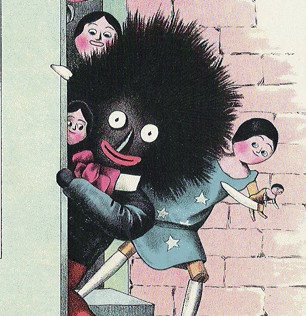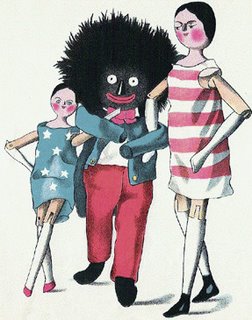



Florence K Upton lived in USA until she was 14 years old when she settled in England with her family. As a child she had a minstrel doll and she ".. knew he was ugly!". The doll was treated roughly by the Upton children. Yet it was to be her inspiration when in 1895 she produced a series of illustrations to accompany a poem-story her mother, Bertha Upton, had written.
"Two Dutch Dolls and a Golliwogg" was the first of 12 books the Uptons would publish. They were immediately popular in England and Europe and the name (eventually shortened to 'golliwog') became an iconic figure, with the release of golliwog dolls and brand logos and other books adopting the character.
The whole of the text and all the book images of Two Dutch Dolls and a Golliwogg are online at the Gutenburg project. I read it all and looked closely at the pictures and I'm inclined to view the book and the illustrations as a whole in an innocent light. It's a pinocchioesque story where caricatures are the norm and it tends towards inclusivity of differences rather than as any vehicle for propagating a racist mentality in my opinion. One could take a perverse view and see other tropes of racism and stereotyping excluding any alleged (intentional or otherwise) slurring against dark skinned people.
But I won't go into any full blown exegesis - I simply like the illustrations - however, I acknowledge that the character and the name have been manipulated and established in many arenas as racist icons. I imagine that feeling is much stronger in the States. There seems to be a stalemate of sorts as to the rightful place deserved for the golliwog character. Because it is an image, there is possibly a stronger evocation of a negative assessment versus, for instance, archaic use of the n-word in literature.
But I don't see any contradiction in having an innocent appreciation for the appearance in history of the golliwog character whilst at the same time detesting the development of the emblem with racist themes.
- Jim Crow Museum of Racist Memorabilia at Ferris University.
- A few larger Two Dutch Dolls illustrations with a front cover sans 'Golliwogg' in the title.
- Golliwogsdotcom have a bunch of book illustrations and fan ephemera - obviously representing one pole on the spectrum of opinion.
- A few illustrations from Golliwogg's Bicycle Tour.
- Golliwogg in wikipedia.
- A great metafilter post on minstrels.
[via]










































5 comments :
Thanks for your thoughtful comment Miranda. I did hesitate before posting it, that's for sure.
I think the original works are worthy historical documents in their own right, both because of the beautiful artwork and indeed because they are apt, in the right situations (and I hope that this site is one), to provoke thought/interest/discussion on a delicate topic. This is a comfortable fence and I like sitting here.
Miranda,
I find it impossible to divorce the golliwog dolls of any meaning. I see these drawings not as symbols of inclusivity between whites and blacks, but as symbols of inclusivity between whites and their minstrels.
I think the problem with this kind of imagery is always going to be inherent in what it represents, not just in what it "represented at the time."
To say that a symbol of opression/inequality is more loaded in one place than another (US vs elsewhere) doesn't make sense to me.
To say that a symbol of opression/inequality is more loaded in one place than another (US vs elsewhere) doesn't make sense to me.
Well then, I'd suggest you need to put yourself into the shoes of people from other places to get a better perspective.
If someone in Holland had one of the golliwog dolls as a child, how on earth could they have associated it with oppression?
The symbol - the golliwog figure - is a very significant emblem of racial ennui in America. Other countries didn't have that as part of their cultural fabric. I live in Australia which of course has its own deplorable history with respect to racial issues, but the golliwog figure is not a traditional icon of that struggle. One has to read about the history of racial problems and the way this figure/doll came to have a strong symbolic connection with black oppression in USA - this is not something that just comes through by osmosis, as would of course have happened for a person growing up in the States.
I understand your reticence in not being able divorce the figure from the symbology, but I hope the context in which this has been posted -- this is a site about illustration and history -- at least doesn't operate to glorify or condone anything other than the illustrative qualities anyway.
Osmosis. . .Are you saying that when looking at art/design it is not important to consider the contexts in which it was created?
Put yourself in Upton's shoes.
Post a Comment
Comments are all moderated so don't waste your time spamming: they will never show up.
If you include ANY links that aren't pertinent to the blog post or discussion they will be deleted and a rash will break out in your underwear.
Also: please play the ball and not the person.
Note: only a member of this blog may post a comment.